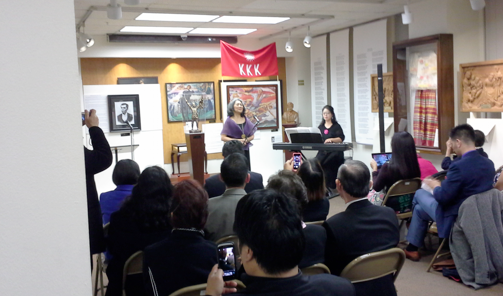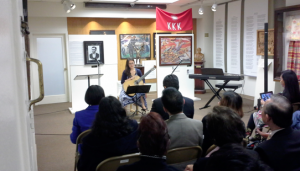
Renowned soprano Evelyn Mandac at “Alay Kay Bonifacio,” accompanied by pianist Judy Lee. CONTRIBUTED PHOTO
SAN FRANCISCO – Renowned soprano Evelyn Mandac, classical guitarist Theresa Calpotura and Philippine Studies students from City College of San Francisco treated the Filipino-American community to a night of poetry and song in celebration of revolutionary hero Andres Bonifacio’s November 30,1863 birthday.
A standing-room-only audience attending the touching “Alay Kay Bonifacio” tribute on November 14 at the Philippine Folklife Museum at the Philippine Center Building on Sutter Street.
During a grand performance, New York soprano Evelyn Mandac gave a heart-tugging rendition of the patriotic song, Kundiman, written by Jose Rizal, the Philippine National Hero so admired by co-patriot Bonifaco. Judy Lee provided the piano accompaniment.
A student soprano in the audience, who sang the same piece elsewhere but is not of Filipino ancestry, acknowledged the depth of sentiment she still has to reach, which Mandac claimed with much ease and feeling.
Mandac delivered nationalist composer Lucio San Pedro’s song, Sa Ugoy ng Duyan (To the Rocking of the Cradle)–about a child’s longing for a mother–with such poignancy that it was easy to conflate the sentiment towards motherhood with that towards the motherland.
A rousing encore of Lulay, a folk tune rearranged by composer Minda Azarcon, ended a very fine tribute to a great hero, Andres Bonifacio.
Honorable life
To live an honorable life (kagalang-galang) and perform good deeds (kawang gawa) was Andres Bonifacio’s message to the fledging Katipunan secret society he and other compatriots founded in 1892 to support, protect and promote the idea of freedom from Spanish colonial rule in the Philippines.
For this occasion, the museum displayed a Bonifacio panel featuring his (only) known official portrait, a small version of his iconic, defiant pose to signal the uprising in Pugad Lawin, and the emblems of the Katipunan—“the loftiest and honorable association of the children of the motherland (Kataas-taasang Kagalang-galangang Katipunan ng Mga Anak ng Bayan).”
On the walls of the museum are wood bass reliefs of the history of the Philippines that visually converge at the center on the portrait of Rizal and his martyrdom at Bagumbayan (Luneta) in front of a Spanish firing squad. The museum reminds Filipinos there is no shortage of heroism and, on this particular evening, no shortage of artistry in song, music and poetry.
Dan de la Cruz, president of the Philippine Folklife Museum Foundation, opened the program, which began with a welcome and invocation by Deputy Consul-General Jaime Ramon T. Ascalon (Consul General Henry S. Bensurto, an expert on South China maritime policy was in Manila).
First republic in Asia
Ascalon reminded the audience about Bonifacio’s role in the development of the modern Philippine Republic. The Katipunan revolt sparked the inevitable emergence of a new nation, the first to free itself from colonial rule in Asia, and the first to establish a republic.
Museum Director of Operations Lydia S. de la Cruz explained the various pieces on the walls and in display cases, urging the audience to use the museum as resource for the San Francisco community to discover the rich history of the Philippines.
Dr. Michael Gonzalez, professor of Philippine history and anthropology at City College of San Francisco Philippine Studies department, took a not so typical evaluation of Bonifacio’s notion of nationalism.
The typical view, propagated in the Philippine public schools and media, is of Bonifacio as a firebrand, a passionate and a quick-tempered revolutionist. Often he is contrasted against Jose Rizal who is more temperate, reflective and reformist.
Gonzalez argued the contrary. Indeed, he said, the times called for passion. That much is expressed in Bonifacio’s poetry, an impassioned exhortation to Filipinos to recognize their oppression.
Citing from the hero’s poem Pagibig sa Tinubuang Lupa (Love of Motherland), the Katipunan documents Kartilya (Code of Conduct) and the anthem Marangal na Dalit ng Katagalugan (Noble Hymn of the Tagalogs), Gonzalez explained that the Katipunan was Bonifacio’s model of a post-colonial society—a “family” that embodied the values of samahan (community), galang (honor), kapatiran (fraternity), kapwa (selfless commensality)–values strengthened through years of surviving colonial oppression.
Fittingly, he said, Bonifacio’s rhetoric focused on the image of motherhood–the Inang Bayan (Motherland). Perhaps, this imagery and sense of longing for the mother comes from Bonifacio’s loss of first his parents, then of his first wife, both from illnesses.
Post-colonial values
A close reading of documents of the Katipunan as a secret society, Gonzalez explained, shows that its mission was to educate its membership with these noble post-colonial values, which would liberate Filipinos from the moral ambiguities that colonialism had impressed upon the native society, leaving them confused and aimless (walang katuwiran).
Ironically, Bonifacio’s demise and violent death in the hands of a rival faction led by Emilio Aguinaldo, presaged what Bonifacio thought must first be corrected for a new nation to begin, Gonzalez suggested,
Motherhood imagery
Ina (mother), Inang Bayan, the Motherland, Prof. were the themes of the ensuing performances.
City College students Maria Asembrana, Vicente Manuel III, and Ferdinand Monica, rendered a heartwarming rendition of Bonifacio’s poem, “Love of Motherland,” in Tagalog and English.
Theresa Calpotura, a well-known San Francisco classical guitarist, played an instrumental version of the “Noble Hymn of the Tagalogs” (the hymn Bonifacio hoped to be the national anthem) composed by his fellow Katipunero Julio Nakpil, who later would marry Bonifacio’s widow.
Calpotura’s next piece, composed by the late Bayani de Leon, expressed longing for a mother who has been away far too long in a foreign land.
The Philippine American Writers Association Inc., sponsored Mandac’s trip to San Francisco where she regularly conducts voice workshops for City College’s Music Department. De la Cruz, who is also a chef, prepared the tasty refreshments, and the ever-hospitable consulate staff made everyone feel welcome.


